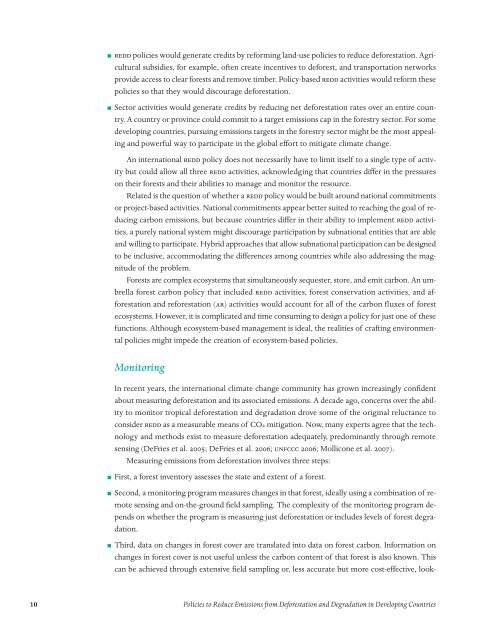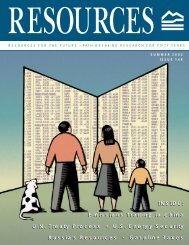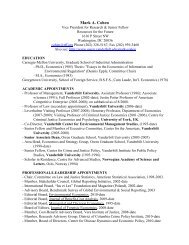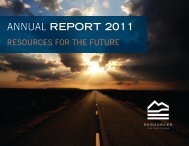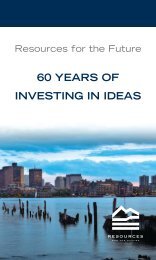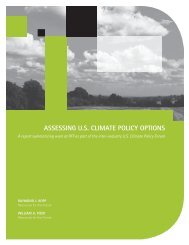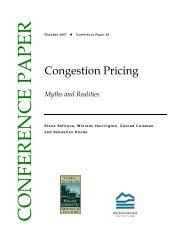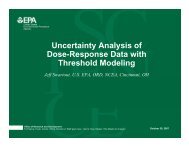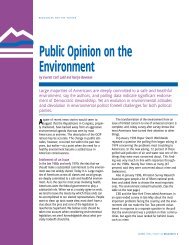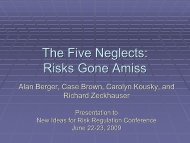Policies to Reduce Emissions from Deforestation and Degradation ...
Policies to Reduce Emissions from Deforestation and Degradation ...
Policies to Reduce Emissions from Deforestation and Degradation ...
You also want an ePaper? Increase the reach of your titles
YUMPU automatically turns print PDFs into web optimized ePapers that Google loves.
∫ REDD policies would generate credits by reforming l<strong>and</strong>-use policies <strong>to</strong> reduce deforestation. Agricultural<br />
subsidies, for example, often create incentives <strong>to</strong> deforest, <strong>and</strong> transportation networks<br />
provide access <strong>to</strong> clear forests <strong>and</strong> remove timber. Policy-based REDD activities would reform these<br />
policies so that they would discourage deforestation.<br />
∫ Sec<strong>to</strong>r activities would generate credits by reducing net deforestation rates over an entire country.<br />
A country or province could commit <strong>to</strong> a target emissions cap in the forestry sec<strong>to</strong>r. For some<br />
developing countries, pursuing emissions targets in the forestry sec<strong>to</strong>r might be the most appealing<br />
<strong>and</strong> powerful way <strong>to</strong> participate in the global effort <strong>to</strong> mitigate climate change.<br />
An international REDD policy does not necessarily have <strong>to</strong> limit itself <strong>to</strong> a single type of activity<br />
but could allow all three REDD activities, acknowledging that countries differ in the pressures<br />
on their forests <strong>and</strong> their abilities <strong>to</strong> manage <strong>and</strong> moni<strong>to</strong>r the resource.<br />
Related is the question of whether a REDD policy would be built around national commitments<br />
or project-based activities. National commitments appear better suited <strong>to</strong> reaching the goal of reducing<br />
carbon emissions, but because countries differ in their ability <strong>to</strong> implement REDD activities,<br />
a purely national system might discourage participation by subnational entities that are able<br />
<strong>and</strong> willing <strong>to</strong> participate. Hybrid approaches that allow subnational participation can be designed<br />
<strong>to</strong> be inclusive, accommodating the differences among countries while also addressing the magnitude<br />
of the problem.<br />
Forests are complex ecosystems that simultaneously sequester, s<strong>to</strong>re, <strong>and</strong> emit carbon. An umbrella<br />
forest carbon policy that included REDD activities, forest conservation activities, <strong>and</strong> afforestation<br />
<strong>and</strong> reforestation (AR) activities would account for all of the carbon fluxes of forest<br />
ecosystems. However, it is complicated <strong>and</strong> time consuming <strong>to</strong> design a policy for just one of these<br />
functions. Although ecosystem-based management is ideal, the realities of crafting environmental<br />
policies might impede the creation of ecosystem-based policies.<br />
Moni<strong>to</strong>ring<br />
In recent years, the international climate change community has grown increasingly confident<br />
about measuring deforestation <strong>and</strong> its associated emissions. A decade ago, concerns over the ability<br />
<strong>to</strong> moni<strong>to</strong>r tropical deforestation <strong>and</strong> degradation drove some of the original reluctance <strong>to</strong><br />
consider REDD as a measurable means of CO2 mitigation. Now, many experts agree that the technology<br />
<strong>and</strong> methods exist <strong>to</strong> measure deforestation adequately, predominantly through remote<br />
sensing (DeFries et al. 2005; DeFries et al. 2006; UNFCCC 2006; Mollicone et al. 2007).<br />
Measuring emissions <strong>from</strong> deforestation involves three steps:<br />
∫ First, a forest inven<strong>to</strong>ry assesses the state <strong>and</strong> extent of a forest.<br />
∫ Second, a moni<strong>to</strong>ring program measures changes in that forest, ideally using a combination of remote<br />
sensing <strong>and</strong> on-the-ground field sampling. The complexity of the moni<strong>to</strong>ring program depends<br />
on whether the program is measuring just deforestation or includes levels of forest degradation.<br />
∫ Third, data on changes in forest cover are translated in<strong>to</strong> data on forest carbon. Information on<br />
changes in forest cover is not useful unless the carbon content of that forest is also known. This<br />
can be achieved through extensive field sampling or, less accurate but more cost-effective, look-<br />
1 <strong>Policies</strong> <strong>to</strong> <strong>Reduce</strong> <strong>Emissions</strong> <strong>from</strong> <strong>Deforestation</strong> <strong>and</strong> <strong>Degradation</strong> in Developing Countries


